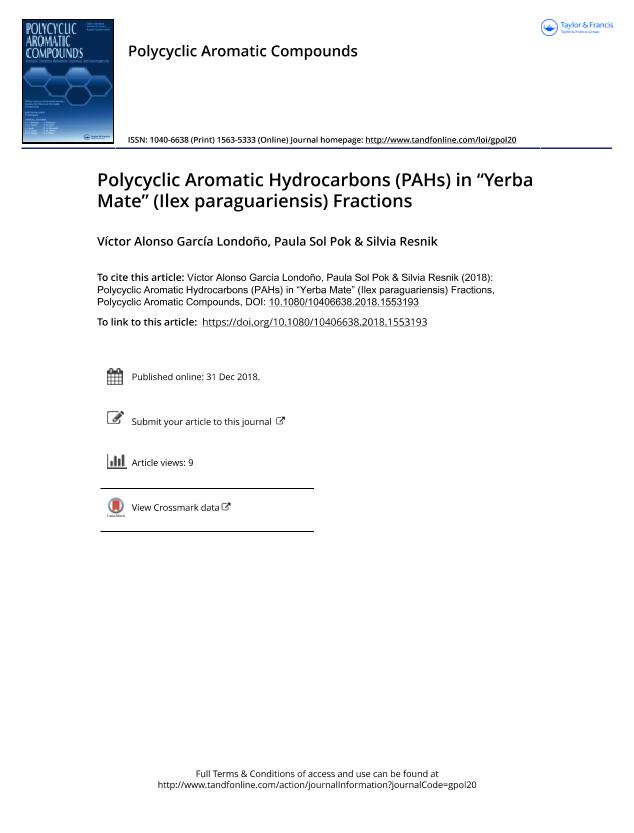Mostrar el registro sencillo del ítem
dc.contributor.author
García Londoño, Víctor Alonso

dc.contributor.author
Pok, Paula Sol

dc.contributor.author
Resnik, Silvia Liliana

dc.date.available
2019-11-25T18:41:42Z
dc.date.issued
2018-12
dc.identifier.citation
García Londoño, Víctor Alonso; Pok, Paula Sol; Resnik, Silvia Liliana; Polycyclic Aromatic Hydrocarbons (PAHs) in “Yerba Mate” (Ilex paraguariensis) Fractions; Taylor & Francis Ltd; Polycyclic Aromatic Compounds; 2018; 12-2018; 1-9
dc.identifier.issn
1040-6638
dc.identifier.uri
http://hdl.handle.net/11336/89694
dc.description.abstract
The aim of this study was to evaluate polycyclic aromatic hydrocarbons (PAHs) contamination, distribution, and toxicity in “yerba mate” fractions, and to propose actions to reduce its pollution. Sixteen PAHs were quantified using a recently developed methodology by HPLC-DAD/FLD, obtaining recoveries higher than 84.5% and relative standard deviation of individual compounds from 0.2% to 9.6%. The PAHs distribution was not normal. The Inverse Gaussian, Birnbaum-Saunders, Lognormal, Gamma, and Weibull were the models that best described benzo(a)pyrene and PAH4 distribution. The fraction that was significantly less contaminated was stem. Also, there was significant difference between leaf and powder fractions, the latter being the one that presented higher PAHs concentration. This may be due to the products generated in the pyrolysis of wood, used in the drying process of “yerba mate.” If powder were removed, a reduction of ∼3.5% of ∑PAHs and 6.5% of TEQ would be achieved. Although eliminating powder could be a strategy to reduce PAHs contamination, this would not be enough to diminish PAHs levels below the regulatory limits.
dc.format
application/pdf
dc.language.iso
eng
dc.publisher
Taylor & Francis Ltd

dc.rights
info:eu-repo/semantics/openAccess
dc.rights.uri
https://creativecommons.org/licenses/by-nc-sa/2.5/ar/
dc.subject
BENZOPYRENE
dc.subject
ILEX PARAGUARIENSIS
dc.subject
ORGANIC CONTAMINANTS
dc.subject
PAH
dc.subject
POLYCYCLIC AROMATIC HYDROCARBONS
dc.subject
YERBA MATE
dc.subject.classification
Alimentos y Bebidas

dc.subject.classification
Otras Ingenierías y Tecnologías

dc.subject.classification
INGENIERÍAS Y TECNOLOGÍAS

dc.title
Polycyclic Aromatic Hydrocarbons (PAHs) in “Yerba Mate” (Ilex paraguariensis) Fractions
dc.type
info:eu-repo/semantics/article
dc.type
info:ar-repo/semantics/artículo
dc.type
info:eu-repo/semantics/publishedVersion
dc.date.updated
2019-10-11T13:49:11Z
dc.journal.volume
2018
dc.journal.pagination
1-9
dc.journal.pais
Reino Unido

dc.journal.ciudad
Londres
dc.description.fil
Fil: García Londoño, Víctor Alonso. Consejo Nacional de Investigaciones Científicas y Técnicas; Argentina. Fundación de Investigaciones Científicas Teresa Benedictina de la Cruz; Argentina. Universidad de Buenos Aires. Facultad de Ciencias Exactas y Naturales. Departamento de Industrias; Argentina
dc.description.fil
Fil: Pok, Paula Sol. Universidad de Buenos Aires. Facultad de Ciencias Exactas y Naturales. Departamento de Industrias; Argentina. Consejo Nacional de Investigaciones Científicas y Técnicas; Argentina
dc.description.fil
Fil: Resnik, Silvia Liliana. Provincia de Buenos Aires. Gobernación. Comisión de Investigaciones Científicas; Argentina. Fundación de Investigaciones Científicas Teresa Benedictina de la Cruz; Argentina. Universidad de Buenos Aires. Facultad de Ciencias Exactas y Naturales. Departamento de Industrias; Argentina
dc.journal.title
Polycyclic Aromatic Compounds

dc.relation.alternativeid
info:eu-repo/semantics/altIdentifier/doi/https://doi.org/10.1080/10406638.2018.1553193
dc.relation.alternativeid
info:eu-repo/semantics/altIdentifier/url/https://www.tandfonline.com/doi/full/10.1080/10406638.2018.1553193
Archivos asociados
